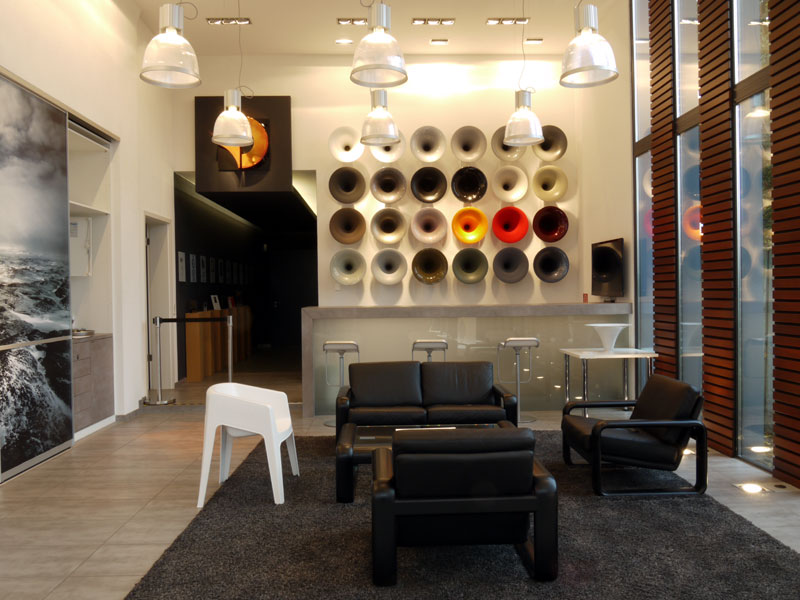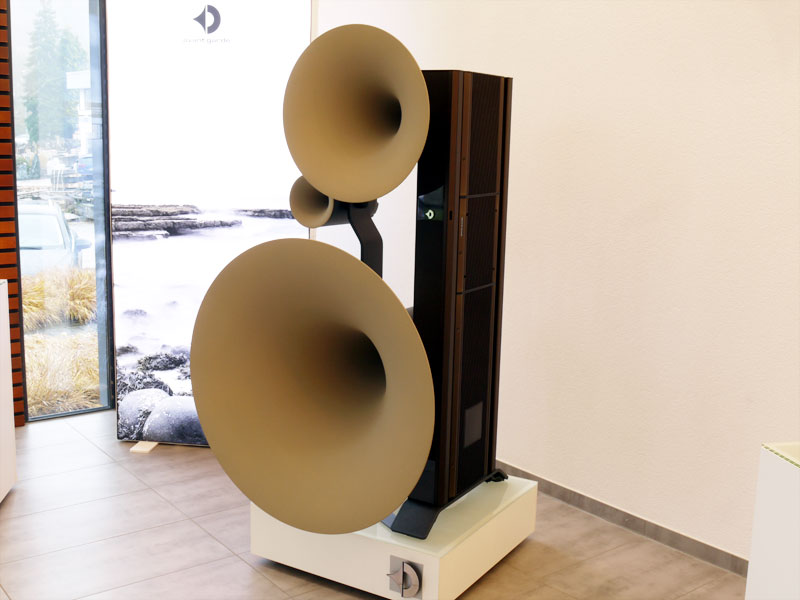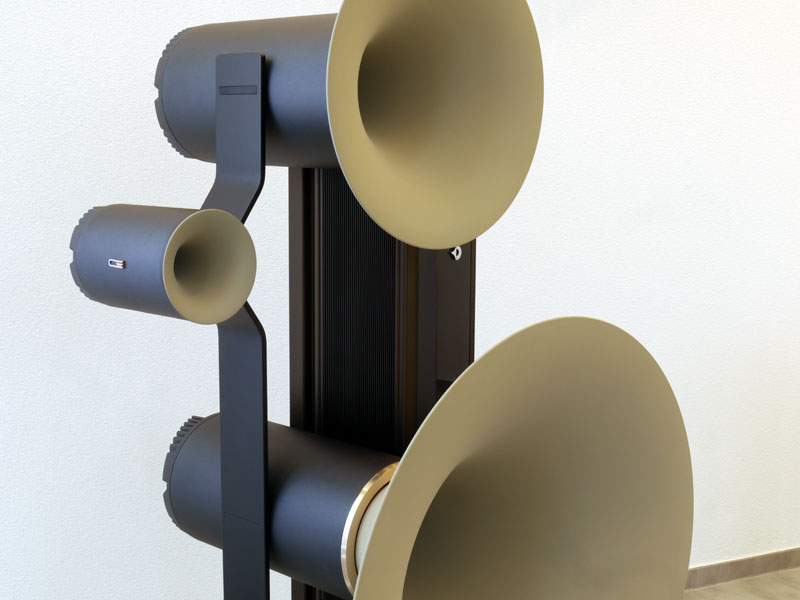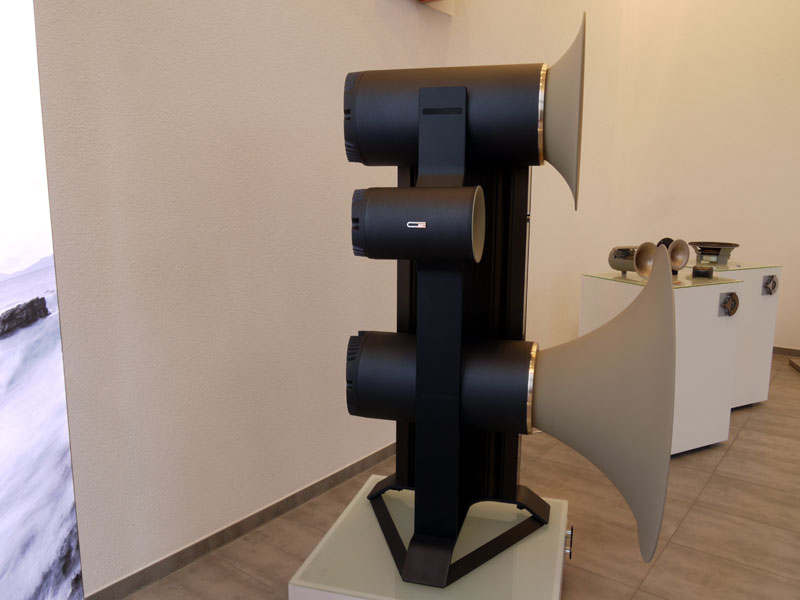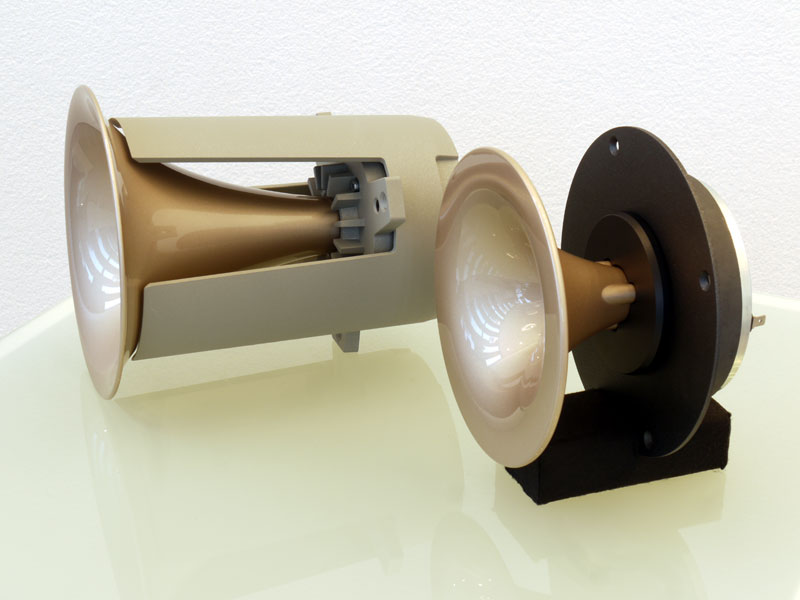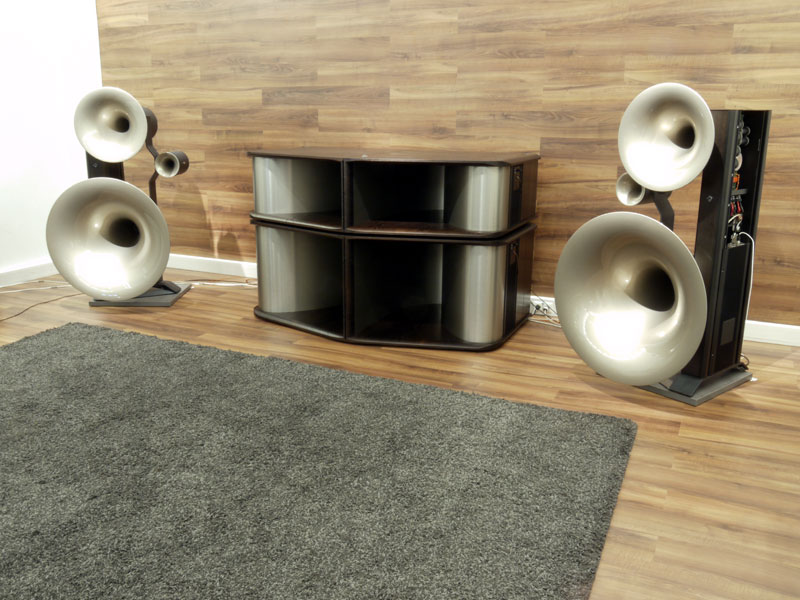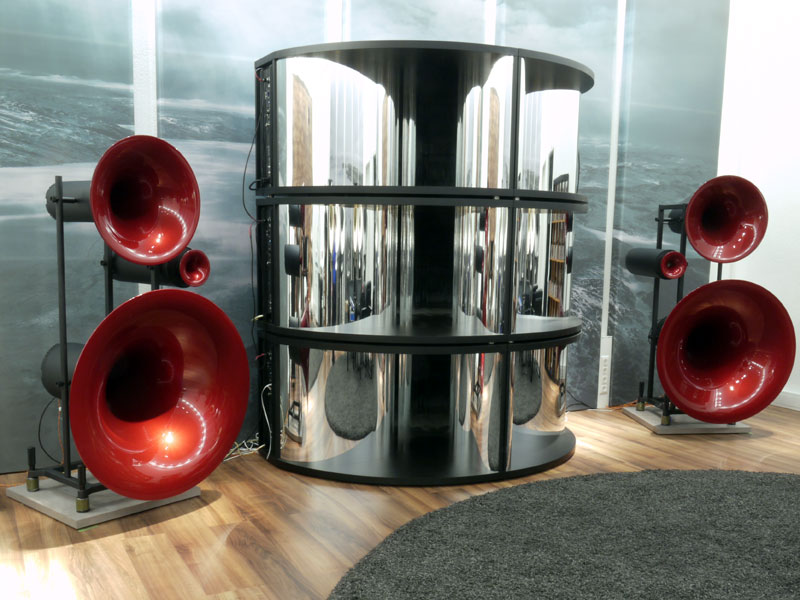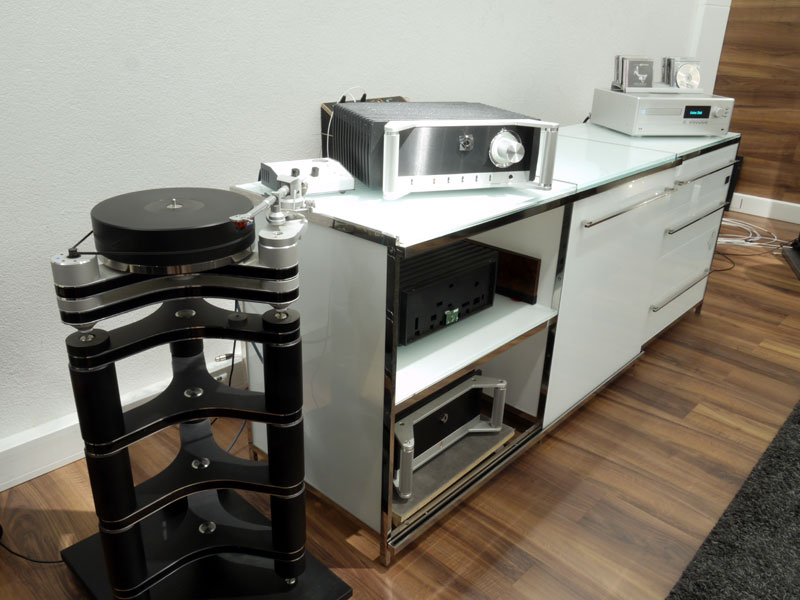When Evolution Becomes Revolution: Experiencing the Transformation of the
Avantgarde Trio
he last time I visited the Avantgarde Acoustic facility in Germany, it was to experience their newly opened showroom. This purpose-built annex allows visitors to experience each and every one of the company’s products: from the compact, innovative, high-tech Zero, with its cast-slab "cabinet" and wireless connectivity; to the legendary Trio, with all the BassHorns you can accommodate. Now, almost ten years later, the modern interior of that facility is just as airy and impressive, the showroom just as welcoming, the coffee just as good. The color of the midrange horns that decorate the wall behind the bar might be different, but that’s not the only thing that has changed. Once a decade -- or so it seems -- the flagship Trio system goes through a major upheaval, the design revisited and reconsidered. After ten years it achieved G2 status; after twenty, it graduated to the XD model. Now, thirty years in, it’s time for another update. But this time, the update is different. This time, after a thirty-year run during which the speaker’s iconic form has remained essentially unchanged, a new Trio is upon us -- and it promises to be as groundbreaking and revelatory as the very first model from three decades ago.
They say that you can trace your audio development through a series of specific, formative experiences -- discrete encounters that shape your view of what is possible and that extend your audio/musical horizons. For me, one of those moments -- one I can remember as clearly as if it was yesterday -- was my first meeting with the original Avantgarde Trio. I can remember the space, the music, the driving system and, if I tell you it took place at the Frankfurt Show, that should also tell you just how long ago it was and therefore the depth of the impression it made. There is simply something fundamentally right, something powerfully and directly communicative, about a well-designed and well-setup horn speaker system. The fact that the Trio’s striking, three-trumpet array has remained essentially unchanged for thirty years tells you a lot. In that time, subtle modifications to drivers and a gradual evolution of the bass bins have stretched the system’s performance envelope, but as prices have risen and the competition has gotten more ambitious, its sheer longevity has created a genuine high-end bargain. For years now, a well-setup Trio system has been able to challenge and seriously frighten all comers, irrespective of price -- often at a fraction of the competing system’s total cost. But because this is the high end, because the Avantgarde speakers lack novelty value and, frankly, because they simply don’t cost enough, many buyers don’t take them seriously. Existing Trio systems start at $65,700 with a pair of Sub 231 bass cabinets, topping out at $153,500 for the top-of-the-line setup with six of the massive BassHorn XDs. That’s not exactly beer-budget pricing, but for a full-range, fully horn-loaded, part-active system with 108dB sensitivity and the sort of headroom and maximum SPLs that mean your ears give up long before the system does, that’s a lot of performance for the money. But in a world full of speakers that cost well north of $500,000 (and plenty that almost double that), there’s an understandable tendency amongst those shopping for the best to dismiss such an "affordable" option. In many cases that’s a mistake -- a mistake that might just have become a catastrophe. It’s all change for the Avantgarde Trio -- and the new speaker seriously ups the ante. Despite still offering performance that is capable of eclipsing the competition, the Trio XD is as demanding of setup and system as it of space, at least if you are going to achieve its full potential. Messing with an iconic design is never something to be taken lightly, especially when that icon has achieved legendary status. Avantgarde’s managing director Holger Fromme (a character almost as iconic as the Trio itself) was clear about two things. On the one hand, the new Trio would have to offer a significant advance in performance while being more compact, versatile and user-friendly. But -- and in design terms, it’s a huge "but" -- on the other, the iconic three-trumpet array was sacrosanct, at least in visual terms. So, merely tweaking the product was never going to be sufficient. Instead, nothing short of a ground-up reinvention was going to meet those lofty goals. But then, in designer Matthias Ruff, someone so brim-full of novel ideas that keeping him under control is a major task, the company certainly has the man for the job. Here was his chance to go hog wild and gather up and propose all those advances he’d been itching to make for years. Which is pretty much what happened.
Dominated by those three visually imposing trumpets, the new Trio G3 is still unmistakably an Avantgarde Trio; but look a little closer and you quickly realize that, short of the midrange and bass horns, pretty much everything else has changed. Let’s start with the drive units. The three main drivers have all been redesigned, with increased power in their motors, evolved diaphragm materials, improved surrounds that remain completely linear throughout their travel, and a newly developed chamber between diaphragm and horn mouth that controls out-of-band output. Although the midrange and bass trumpets remain unchanged, the tweeter horn has been redesigned and is now almost twice the length of the old one, with a 25% increase in the radiating area. That allows the new XT3 drive unit to use a smaller, annular diaphragm, significantly reducing distortion, while extending both bandwidth and headroom. For the first time in the Trio’s thirty-year lifespan, the offset tweeter horn can be precision adjusted, fore and aft, to maintain driver time alignment, irrespective of toe-in. That might not sound too dramatic, but in setup terms it solves one of the biggest challenges facing the Trio owner.
The new spherical horn array is mated to an all-new framework, which is where things get very different -- and very interesting indeed. The old space frame, so much a signature of the original Trio design, is gone. Instead, the simple cruciform base is replaced with a sculpted and carefully profiled triangular foot. Hidden spikes (vital to achieving the correct attitude and rake angle for the horn array) visually lift the speaker clear of the floor, supporting the vertical elements, which in turn support the driver barrels. The tweeter, which used to be bolted to a pair of square-section poles, is now "flown" from a beautifully profiled and curved aluminum extrusion. The depth of the supporting surface allows for the sliding adjustment mechanism.
On the opposite side of the frame, tucked behind the midrange and bass horns, is a substantial vertical column, the narrow side of its rectangular footprint facing forward. This 5.5”/140mm wide, 18”/457mm deep and fully 58”/1473mm tall, finned, extruded chassis contains the speaker’s electronic elements -- and represents the biggest change in the Trio’s configuration. In keeping with its moniker, the Trio G3 isn’t one speaker but has become three. The modular, upgradeable electronics package allows users to specify the system as a conventional passive setup, an active system requiring only a line-level feed, or, in its ultimate form as an active, wireless setup. That’s quite a departure from the original, but while the option to specify or add active operation to speakers isn’t unique, the electronics package being offered by Avantgarde most certainly is.
The iTron amplification operates using current drive, and that makes it unusual and special indeed. For those unfamiliar with the concept (which probably means most of us), a full explanation of the operational advantages and restrictions of a current-drive system will have to wait for a full review. What you need to know is that, as the name suggests, current drive delivers the driving current to a loudspeaker voice coil without the rise-time delays or dynamic limitations suffered by voltage-dependent circuits. Data supplied by Avantgarde suggests that the current supplied by the iTron drive tracks the input voltage all but instantly and almost perfectly. Now, for those of a technical bent to whom that sounds suspiciously like marketing fluff, or those who are simply suspicious, I was skeptical too, so I sought out additional information. The best source I found was a Finnish article, "Comparative Measurements on Loudspeaker Distortion: Current vs. Voltage Control" by Esa Meriläinen. After ten pages of learned discourse and supporting measured results, the conclusion is as stark as it is understated:
But if that’s the case, why don’t more amplifiers use this technology? The answer lies in the inherent limitations of the approach. As any half-competent electrical engineer will tell you, a current converter is the way a drive unit should be driven -- right before he tells you why the design of most loudspeakers makes it impossible. A current-drive system cannot control a driver at its resonant frequency (where diaphragm movement starts to become exaggerated), instead simply trying to dump more and more power into the rising impedance, causing exaggerated output and ultimately, potential damage. To make matters worse, the filter circuits used in passive crossovers filter voltage and are effectively invisible to current, so a current-drive amplifier simply floods the network, making it incompatible with almost all loudspeakers and useless as a generally applicable technology. But what if? What if a current-converter system could be made to work or, more specifically, a given loudspeaker’s particular characteristics allowed it to? Look at the Trio and you see those three big trumpets. But consider it in frequency terms and that main horn array, for all its size, only reaches down to around 100Hz -- well above the fundamental resonance of the midbass driver. The other drivers are all purpose-built and employed well above their resonant frequencies. In design terms, it’s a perfect storm of opportunity. Here’s a situation where the amplifier designer also controls both the topology and the bandwidth of the drivers and loudspeaker itself. Use an active crossover and suddenly current drive offers too many advantages to ignore. Throw in the fact that the Trio is already committed to using separate subs, and Matthias Ruff had an unassailable argument. Mind you, winning the argument was one thing; designing a practical amplification package was quite another. The end result isn’t just unusual -- it’s patentable. Essentially a zero-feedback, voltage-current converter, the iTron is genuinely unique -- and listening to it only serves to underline that point. It was the chance to hear not just a new Trio, but a genuinely revolutionary system solution that drew me to Avantgarde this time round. Not that I required much encouragement. Before we get to listening, I should mention the new SpaceHorn subwoofers. These replace the old, semi-circular BassHorns with a new squarer, more compact but far more powerful design. Available in single- and twin-driver versions, the new SpaceHorn features an all-new DSP-controlled active crossover, with sophisticated equalization and rolloff adjustments. The folded horn is almost twice as long as the one in the BassHorn and delivers an 8dB increase in sensitivity. Designed to be deployed in pairs or separately in corners, stood horizontally or vertically, single-driver and twin-driver models can be mixed and matched, while a six-driver array is roughly half the size of the old BassHorn equivalent -- and significantly more powerful to boot. Smaller, more versatile and more powerful, the SpaceHorn ticks all those "increased practicality" boxes. If you are thinking that all that new and revised technology sounds expensive, you’d be right. But compared to the benchmark, conventional amplifier/speaker combinations it faces as competition, the Avantgarde Trio G3s look almost modestly priced. In the US, the various components will set you back: Trio G3 (passive), $95,000/pair Let me do the sums for you. A set of active G3s with twin-driver SpaceHorns runs out at $221,000 -- which positions them well above the middleweight offerings from Wilson, Stenheim and the like. That might raise a few eyebrows, except that the Avantgarde price includes six channels of genuinely exceptional, cutting-edge amplification, active crossovers and active subwoofers. With a spec that includes full-bandwidth performance and 108dB sensitivity, that’s starting to look like an awful lot of speaker for the money. As I was about to discover, it’s an awful lot of performance too.
Arriving at Avantgarde, I discovered a set of the new Trio G3s, along with a stack of SpaceHorns, just waiting to be auditioned. But more interestingly, the system was set up to allow on-the-fly comparisons between the passive setup (driven by a pair of Avantgarde’s excellent XA power amps) and the fully active, iTron-driven flagship model. The rest of the system consisted of a Clearaudio Innovation turntable with Unify tonearm and Da Vinci cartridge, a prototype phono stage, and an XA Pre line stage. Digital disc was replayed on a T+A MP2500 player, used as a transport to feed a prototype DAC. If you think Avantgarde is only about big, brightly colored trumpets, that little list should make you think again.
There was also a set of Trio XDs with BassHorns, which is where the listening started, but it was instantly apparent that, even in passive form, the G3/SpaceHorn combination was in a completely different league, leaving the older speakers sounding thin, disjointed and musically awkward. In fact, a direct blind comparison might lead you to question whether the G3 is a horn speaker at all, such is its sense of rounded warmth, body and integration. Voices and instruments were significantly more natural and more naturally dimensioned. The sense of pace and timing in music was far more explicit. The latest Trio has none of the spatial or tonal discontinuities, honky colorations or thinness that horns are so often accused of. Instead, the sound is remarkable for its broad spread, coherence and set-back stereo perspective. If you are expecting shouty and forward, you are going to need to look elsewhere.
But the real shock comes when you switch to active iTron drive. It’s not so much a case of a veil being lifted as taking off the brakes. The music steps forward, bringing you closer to the band -- a band that seems to have suddenly woken up and sprung into action. There’s an immediacy and snap to the playing that bring clarity and intimacy, musical chemistry and communication. Textures and harmonic layers, phrasing and articulation aren’t so much improved as laid bare, just another aspect of the musical whole to be savored and enjoyed. Rarely has the sheer gusto with which Sol Gabetta assaults Vivaldi’s "Winter" (from The Four Seasons, Il Progetto Vivaldi [RCA 88697131691]) been so perfectly projected, rarely has the sheer energy and control required to drive her cello through the rapidly shifting score been so apparent -- or impressive. The subtleties in complex, layered productions were effortlessly unraveled, the spurious noises and instrumental or vocal interjections that litter so many modern pop recordings seemed to pop within the soundfield, while voices had an extraordinarily natural and communicative power. This is performance that is way closer to the very best available than it is to those mid-level, middleweight systems I mentioned earlier -- and that’s with a single pair of the twin-driver SpaceHorns. That makes the price distinctly mid-level when compared to the likes of the Wilson XVX, Living Voice Vox Palladian, Göbel Divin Majestic or big Tidal speakers, products that are the Trio G3/iTron’s natural competition. Avantgarde hasn’t just reworked the Trio,
they’ve transformed the speaker, while the iTron active module adds something very
special indeed. Together with the SpaceHorns, the fully active Trio G3 is just as
revolutionary and has had just as significant an impact on my sensibilities as the
original Trio did, three decades ago. So here’s another sum: 95 + 38 + (88 x 3) =
397. That’s $397,000 for the fully active Trio G3/six Twin driver SpaceHorn system.
Maybe from that price perspective, customers might start taking the German trumpets a
little more seriously. And that’s before they hear them. The current fashion in
marketing and politics is for disruptors, and Avantgarde's latest assault on the audio
high-end looks like being very disruptive indeed. If spherical horns were a culture shock,
wait until you hear iTron. Ultimate judgment will need to wait for the full review, but at
these prices and delivering this level of performance, despite the eye-watering overall
price, the Trio G3 still looks and sounds like an absolute bargain. This is one form of
shock treatment you won’t just enjoy; its immediacy and musicality could easily
become addictive. |

